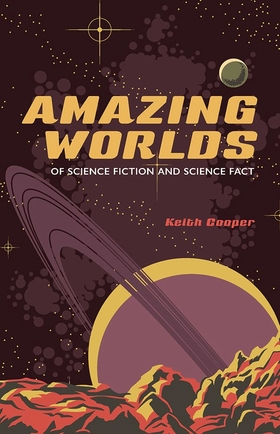Centauri Dreams
Imagining and Planning Interstellar Exploration
PicSat: Eye on Beta Pictoris
To understand why Beta Pictoris is receiving so much attention among astronomers, particularly those specializing in exoplanets, you have only to consider a few parameters. This is a young star, perhaps 25 million years old, one with a well observed circumstellar disk, the first actually imaged around another star. We not only have a large gas giant in orbit here, but also evidence of cometary activity as seen in spectral data. ? Pic is also relatively nearby at 64 light years.
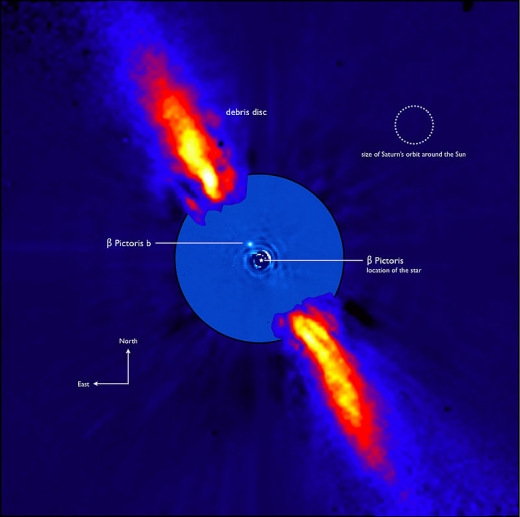
Image: This composite image represents the close environment of Beta Pictoris as seen in near infrared light. This very faint environment is revealed after a careful subtraction of the much brighter stellar halo. The outer part of the image shows the reflected light on the dust disc, as observed in 1996 with the ADONIS instrument on ESO’s 3.6 m telescope; the inner part is the innermost part of the system, as seen at 3.6 microns with NACO on the Very Large Telescope. The newly detected source is more than 1000 times fainter than Beta Pictoris and aligned with the disc. Both parts of the image were obtained on ESO telescopes equipped with adaptive optics. Credit: ESO/A.-M. Lagrange et al.
Consider this star, then, a conveniently close laboratory for the study of how stellar systems form. ? Pic b, about seven times as massive as Jupiter, was discovered in 2009 by a French team led by Anne-Marie Lagrange (CNRS/Université Grenoble Alpes). The planet orbits at 1.5 billion kilometers, roughly the distance of Saturn from our Sun, but there is also the possibility of other planets now in formation within the debris disk. Indeed, the observed structure of planetesimal belts here is a possible indication of smaller planets we have not yet observed.
While ? Pic b was discovered by direct imaging, there are interesting transit possibilities that are now being explored by scientists at the Paris Observatory and the Centre National De La Recherche Scientifique (CNRS). With launch scheduled for tomorrow, PicSat is a nanosatellite built on a CubeSat platform, one containing a 5 cm telescope destined for the study of ? Pic. PicSat will use no more than 5 watts of power in the attempt to view a transit of ? Pic b.
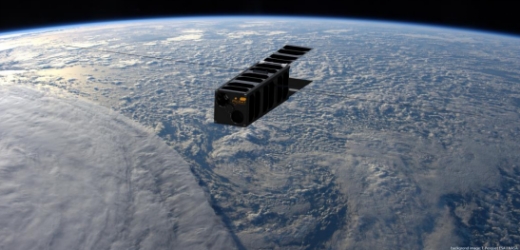
Image: An artist’s impression of PicSat in orbit around the Earth. Credit and copyright: T. Pesquet ESA / NASA – LESIA / Observatoire de Paris.
We don’t have a firm idea of exactly when the transit will occur, but scientists with the project peg any time between now and the summer of this year. A transit here would last only a few hours, but it would give us information about the size of the planet, the extent of its atmosphere and its chemical composition. The beginning of a transit will trigger an alert to the 3.6 meter telescope at the European Southern Observatory’s La Silla site, where the HARPS (High Accuracy Radial velocity Planet Searcher) spectrograph can be used to study the event.
Keeping a continuous eye on ? Pic to spot the beginning of the transit is thus an imperative. Transits are expected to occur only every 18 years, and indeed PicSat was designed and constructed in just three short years. Modular methodologies to the rescue as we are reminded once again that simple resources like CubeSats are capable of world-class science.
Launch is scheduled for 12 January at 0358 UTC (2258 EST) aboard an Indian PSLV launcher, with the satellite inserted into a polar orbit at an altitude of 505 kilometers, a tandem launch that will include some thirty other satellites. While the satellite will be operated from Meudon in France, a facility of the Paris Observatory, PicSat uses radio amateur bands for communication.
Citizen scientists therefore take note: The PicSat team is opening the door for radio amateurs worldwise to collaborate in tracking the satellite, receiving data and relaying them to the PicSat database over the Internet. Have a look at the PicSat website for information on how to register to become part of this ad hoc radio network and follow PicSat updates. The site has been down this morning, presumably because of last minute updates, but keep checking.
Pssst everyone. It is PicSat, from the inside on top of the #PSLVC40 launcher, whispering, must disturb my co-travellers. It is 9h28m AM here in Sriharikota, 4h58m AM in Paris. That means 24 hours to ignition … & counting 23:59:59, 23:59:58, 23:59:27 …. sooo excited! #CubeSat pic.twitter.com/dnTqJPZ3EY
— PicSat (@IamPicSat) January 11, 2018
Achieving great things with small packages is becoming part of our culture, and we can wish French space agency CNES and PicSat a safe launch as it begins its one year mission. The launch will be covered live here and you can keep up with PicSat events at https://twitter.com/IamPicSat, or check out its YouTube channel.

Exploring Origins of a Fast Radio Burst
Fast Radio Bursts (FRBs) continue to intrigue us given their energy levels. You may recall FRB 121102, which was revealed at a press conference almost exactly one year ago to be located in a radio galaxy some 3 billion light years away. This is a repeating FRB (the only repeating source yet found), making its study an imperative as we try to characterize the phenomenon.
With data from Arecibo, the Very Large Array and the European VLBI network, astronomers determined its position to within a fraction of an arcsecond, where a source of weak radio emission is also traced. Today, drawing on new observations from Arecibo and the Green Bank instrument in West Virginia, we learn something about the source of these bursts.
The energies we are talking about are obviously titanic. Given the distance between the source and us, researchers have calculated that each burst throws as much energy in a single millisecond as our Sun releases in an entire day. And as we learn in the latest issue of Nature, an international team has been able to show that the bursts from FRB 121102 are highly polarized, allowing insights into the environment from which it sprang. The analysis was revealed at a meeting of the American Astronomical Society in Washington, D.C.
In play here is a phenomenon known as Faraday rotation, which is the ‘twisting’ that happens to polarized radio waves as they pass through a magnetic field. And what stands out in these findings is the apparent strength of the magnetic field involved, for the Faraday rotation is extreme, among the largest ever measured in a radio source. The implication: The bursts are evidently moving through an exceedingly powerful magnetic field in a dense plasma.
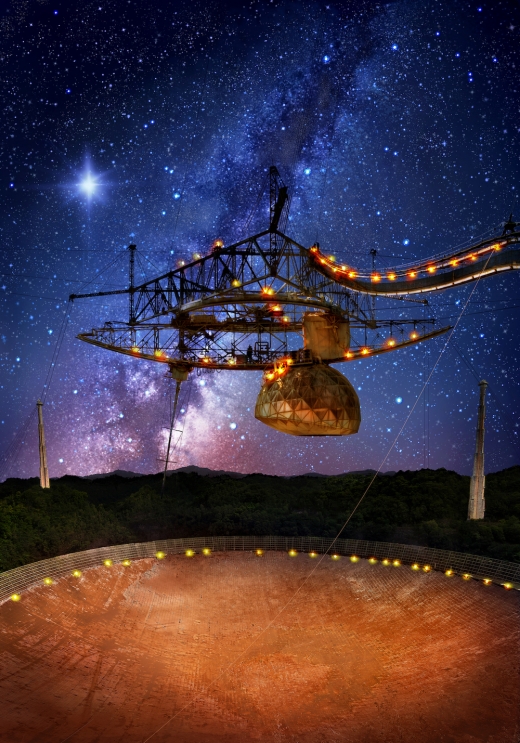
Image: The 305-metre Arecibo telescope, in Puerto Rico, and its suspended support platform of radio receivers is shown amid a starry night. A flash from the Fast Radio Burst source FRB 121102 is seen: originating beyond the Milky Way, from deep in extragalactic space. Credit: Image design: Danielle Futselaar – Photo usage: Brian P. Irwin / Dennis van de Water / Shutterstock.com.
We now move into the realm of speculation. Is FRB 121102 situated close to a massive black hole at the center of its host galaxy? That would correspond to some degree with the magnetized plasmas that have been observed in the Milky Way, associated with its own supermassive black hole. But there are other possibilities, as Arecibo staff astronomer Andrew Seymour comments, referring to the FRB observations at higher radio frequencies than before:
“We developed a new observing setup at the Arecibo Observatory to do this, and our colleagues from Breakthrough Listen at the Green Bank Telescope confirmed the results with observations at even higher radio frequencies. What’s more, the polarization properties and shapes of these bursts are similar to radio emission from young, energetic neutron stars in our galaxy. This provides support to the models that the radio bursts are produced by a neutron star.”
But given that it is the only repeating FRB, is FRB 121102 somehow different from all other, non-repeating FRBs? Bursts from the former have been observed with as many as seven peaks, a more complicated structure in time and radio frequency than observed in other FRBs, which show one or occasionally two peaks in time.
“We’ve observed bursts from FRB121102 with as many as seven peaks, and the bursts peak in radio frequency as well as time,” says Laura Spitler, an astronomer at the Max-Planck-Institut für Radioastronomie, Bonn. “We are now trying to understand whether the bursts’ structure is an intrinsic feature of the process that generates the radio emission or the result of the propagation through the dense plasma local to the source.”
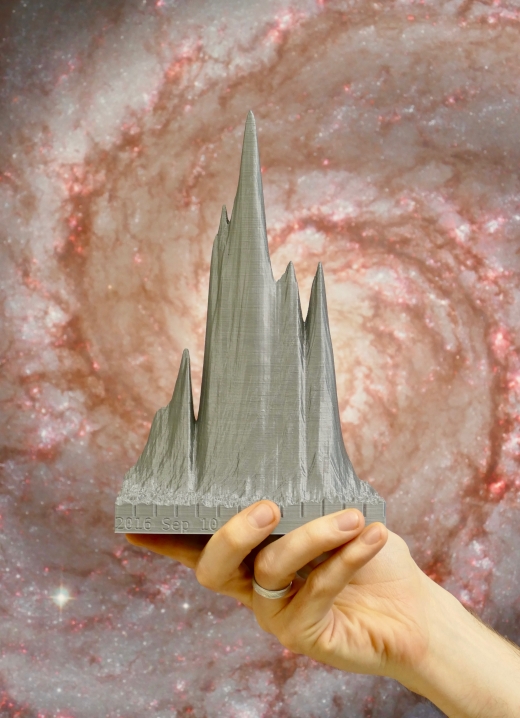
Image: One of FRB121102’s radio bursts, as detected with the Arecibo telescope. This 3D print shows how bright the burst is as a function of observed radio frequency and time. Credit: Anne Archibald (University of Amsterdam).
We may get some help in the next phase of the investigation from CHIME (Canadian Hydrogen Intensity Mapping Experiment), an interferometric radio telescope under construction in British Columbia, which should be coming online later this year. The researchers believe the instrument will be well-tuned for the detection of FRBs and for studying their degrees of polarization. McGill University’s Shriharsh Tendulkar believes CHIME will be capable of detecting “…between a few and a few dozen FRBs every day.”
Also in the cards is future observation at Green Bank, where Breakthrough Listen has allotted more time to study not just the emissions of FRB 121102, but also other FRB sources. The plan is to observe at higher frequencies, up to 12 GHz — the current Green Bank work has taken place from 4-8 GHz. Whether or not the energy of FRB 121102 drops off at higher frequency may provide additional insights into its source.
The paper is Michilli et al., “An Extreme Magneto-Ionic Environment Associated with Fast Radio Burst Source FRB121102,” Nature 11 January 2018 (abstract).

Exoplanet Prospects at Earth-based Observatories
Although I often write about upcoming space missions that will advance exoplanet research, we’re also seeing a good deal of progress in Earth-based installations. In the Atacama Desert of northern Chile, the Extremely Large Telescope is under construction, with first light planned for 2024. With 256 times the light gathering area of the Hubble instrument, the ELT is clearly going to be a factor in not just exoplanet work but our studies of numerous other astronomical phenomena, from the earliest galaxies in the cosmos to the question of dark energy.
Today we learn that the first six hexagonal segments for the ELT’s main mirror have been cast by the German company SCHOTT at their facility in Mainz, Germany. We’re just at the beginning of the process here, for the primary mirror is to be, at 39 meters, the largest ever made for an optical-infrared telescope. 798 individual segments — each 1.4 meters across and 5 centimeters thick — will go into it, working together as a single gigantic mirror.

Image: The first six hexagonal segments for the main mirror of ESO’s Extremely Large Telescope (ELT) have been successfully cast by the German company SCHOTT at their facility in Mainz. These segments will form parts of the ELT’s 39-metre main mirror, which will have 798 segments in total when completed. The ELT will be the largest optical telescope in the world when it sees first light in 2024. Credit: ESO.
SCHOTT will embark on making a total of 900 segments, 798 for the primary mirror plus a spare set, with production rates when up to speed of about one segment per day. After cooling and a heat treatment sequence, the mirror segment blanks will be ground and polished to a precision of 15 nanometers, with shaping and polishing performed by the French company Safran Reosc, which will mount and test the individual segments.
Binocular Vision
Meanwhile, we also get word of two new instruments that will be mounted on the Large Binocular Telescope (LBT), located on Mount Graham in Arizona. The SHARK instruments (System for coronagraphy with High order Adaptive optics from R to K band) are designed with an explicit exoplanet purpose, to conduct direct imaging of distant worlds.
What makes the SHARK effort intriguing is that it comprises two instruments. SHARK-VIS works in visible light, SHARK-NIR in near-infrared, and on the LBT platform, the two will be operated in parallel, using the two 8.4-meter mirrors of the observatory. Built by an international consortium led by INAF, the Italian National Institute for Astrophysics, the two SHARK instruments will likewise take advantage of the observatory’s adaptive optics system, also developed by INAF. Adaptive optics corrects for distortions caused by turbulence in the Earth’s atmosphere.
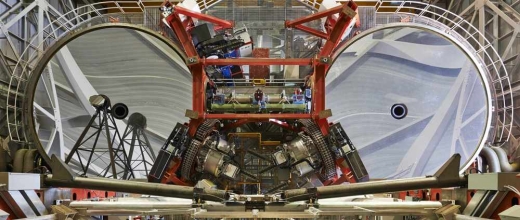
Image: Each SHARK will be installed on one side of the LBT Interferometer (LBTI), the green structure seen in the middle of the picture between the two main mirrors of LBT. Credit: SHARK Consortium/INAF.
Notice what’s happening here: The LBT, once equipped with the two SHARK add-ons, becomes the first telescope in the world that can observe exoplanets simultaneously over such a wide range of wavelengths, helping astronomers tease out planets that would otherwise be drowned in the glare of the host star. The installation, which is expected to be completed in 2019, also points the way toward the upcoming Giant Magellan Telescope, which will deploy seven 8.4-meter mirrors on the same mount instead of the LBT’s two. The GMT facility is under construction at the Las Campanas Observatory in Chile’s southern Atacama Desert.
“With SHARK, we will observe exoplanets at unprecedented angular resolution and contrast, so that we will be able to go closer to their host stars than what has been achieved up to now with direct imaging,” says Valentina D’Orazi of the INAF-Osservatorio Astronomico di Padova, instrument scientist for SHARK-NIR. “This will be possible thanks to the use of coronagraphy, which blocks out the light from the central star and highly improves the contrast in the region around the source, thus allowing us to detect the planetary objects we want to study, which otherwise would remain hidden in the star light.”
Clearly we’re moving into an era where Earth-based observatories will be capable of major advances in the exoplanet hunt, complementing the upcoming space missions that will expand the planetary census and begin the analysis of smaller exoplanet atmospheres, particularly those around red dwarf stars. Both the Extremely Large Telescope and the Giant Magellan Telescope could be completed, if current schedules are realistic, by 2025.
An Ancient Planetary System
I just noticed that the team behind PEPSI (Potsdam Echelle Polarimetric and Spectroscopic Instrument) at the Large Binocular Telescope has released three papers analyzing high spectral resolution data from the site. Because I’ve only had the chance to skim the papers, let me just quote the news release on one of these, examining the 10-billion year old system Kepler-444:
…the star “Kepler-444”, hosting five sub-terrestrial planets, was confirmed to be 10.5 billion years old, more than twice the age of our Sun and just a little bit younger than the universe as a whole. The star is also found being poor on metals. The chemical abundance pattern from the PEPSI spectrum indicates an unusually small iron-core mass fraction of 24% for its planets if star and planets were formed together. For comparison, terrestrial planets in the solar system have typically a 30% iron-core mass fraction. “This indicates that planets around metal-poor host stars are less dense than rocky planets of comparable size around more metal-rich host stars like the Sun”, explains Claude “Trey” Mack, project scientist for the Kepler-444 observation.
The paper is Mack et al., “PEPSI deep spectra. III. A chemical analysis of the ancient planet-host star Kepler-444,” in press at Astronomy &Astrophysics (preprint).

Tightening the Focus on Brown Dwarfs
Among the many indicators that we have much to learn about brown dwarfs is the fact that we don’t yet know how frequently they form. Recent work from Koraljka Muzic (University of Lisbon) and colleagues has pointed, however, to quite a robust galactic population (see How Many Brown Dwarfs in the Milky Way?). Working with observations at the Very Large Telescope, the study pegged the brown dwarf population at 25 billion, with a potential of as many as 100 billion.
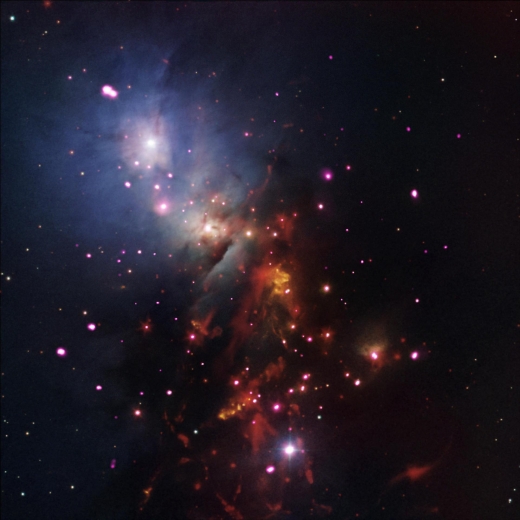
Image: Stellar cluster NGC 1333 is home to a large number of brown dwarfs. Astronomers will use Webb’s powerful infrared instruments to learn more about these dim cousins to the cluster’s bright newborn stars. Credit: NASA/CXC/JPL.
Likewise in need of further data is our understanding of how brown dwarfs form, especially in the region where planet and star overlap. Recall that brown dwarfs are not main sequence stars, as they are not massive enough to ignite hydrogen fusion, even if deuterium and lithium fusion may occur. If we get down to brown dwarfs less than 13 times the mass of Jupiter, are we dealing with planets or stars? And do these objects form as planets (within a circumstellar disk) or as stars (via the collapse of interstellar gas)?
Aleks Scholz (University of St Andrews, UK) will be using the James Webb Space Telescope (assuming successful launch and deployment next year, fingers crossed) to study the cluster in the image above, NGC 1333 in Perseus. A number of brown dwarfs have been located within the cloud, which is itself considered to be a stellar birthing ground for young stars. Usefully, NGC 1333 also appears to contain brown dwarfs at the very low end of the mass distribution.
“In more than a decade of searching, our team has found it is very difficult to locate brown dwarfs that are less than five Jupiter-masses – the mass where star and planet formation overlap. That is a job for the Webb telescope,” Scholz says. “It has been a long wait for Webb, but we are very excited to get an opportunity to break new ground and potentially discover an entirely new type of planets, unbound, roaming the Galaxy like stars.”
Note the the Substellar Objects in Nearby Young Clusters (SONYC) project, which Scholz leads. The goal is to study the frequency and properties of brown dwarfs in star-forming regions (Koraljka Muzic is part of this collaboration, which also includes Toronto’s Ray Jayawardhana). Below is an image showing brown dwarfs in NGC 1333 as identified by the survey.
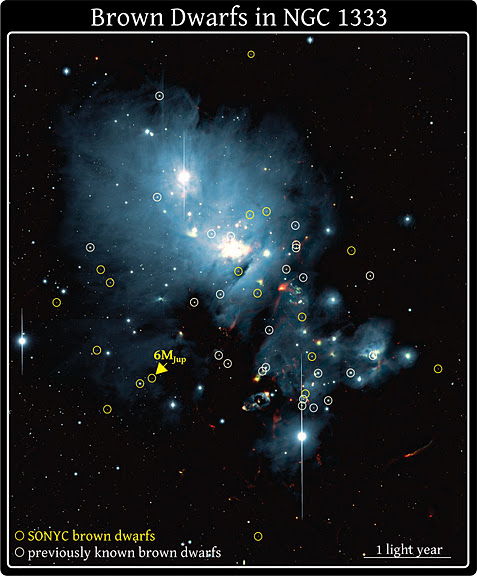
Image: Brown dwarfs in the young star cluster NGC 1333. This photograph combines optical and infrared images taken with the Subaru Telescope. Brown dwarfs newly identified by our SONYC Survey are circled in yellow, while previously known brown dwarfs are circled in white. The arrow points to the least massive brown dwarf known in NGC 1333; it is only about six times heftier than Jupiter. Credit: SONYC Team/Subaru Telescope.
Likewise planning to use JWST to address brown dwarf issues is Étienne Artigau (Université de Montréal), who will be looking at an interesting low-mass brown dwarf called SIMP0136. We’ve looked previously at the work Jonathan Gagné (Carnegie Institution for Science) has performed on this one, a brown dwarf whose variability in brightness has been attributed to weather patterns moving into view during its short (2.4 hour) rotation period. Gagné’s team, studying SIMP0136’s membership in a nearby moving group, has pegged its mass at 12.7 Jupiter masses. See Exploring the Planet/Brown Dwarf Boundary for more.
This is an interesting object on a number of counts, not the least of which is the fact that it is a bit less than 20 light years out, making it one of the 100 nearest systems to the Sun. Also noteworthy is the fact that it is a free-floating object not associated with any star, a low-mass brown dwarf on the planet/brown dwarf boundary that in many ways resembles a gas giant. The Webb instrument should be just the ticket for pushing our understanding further.
“Very accurate spectroscopic measurements are challenging to obtain from the ground in the infrared due to variable absorption in our own atmosphere, hence the need for space-based infrared observation. Also, Webb allows us to probe features, such as water absorption, that are inaccessible from the ground at this level of precision,” Artigau explains.
Let’s place SIMP0136 into context, then, as we look toward the next generation of space-based exoplanet work. We know that a potent tool for atmospheric analysis will be transmission spectroscopy, conducted as a planet moves in front of its star as seen from Earth. In SIMP0136, we have an object with gas giant characteristics unhampered by proximity to a star. Artigau goes on to point out in this NASA news item that we can use it to better understand cloud decks in brown dwarf and planet atmospheres as we contrast the two kinds of observation.
One day we’ll have a better idea of how many unbound planetary-mass objects are out there. That they are hard to discover goes without saying, and we’ve only located a few on the brown dwarf/planet boundary. But it’s clear that the attention now being devoted to them through efforts like the Substellar Objects in Nearby Young Clusters project as well as the BANYAN All-Sky Survey-Ultracool (BASS-Ultracool) will, with the aid of space-based instruments, tell us much more. The resource list on the BASS-Ultracool page offers abundant references.

2017 from an Interstellar Perspective
The recent burst of interest in interstellar flight has surely been enhanced by the exoplanet discoveries that have become almost daily news. Finding interesting planets, some of them with the potential for water on their surfaces, inevitably raises the question of how we might find a way to get there. We can only imagine this accelerating as missions like the Transiting Exoplanet Survey Satellite (TESS) and the James Webb Space Telescope begin to fill in not just our inventory of nearby planets but our understanding of their compositions.
Find a terrestrial class planet around another star — we may find that there is more than one around the Alpha Centauri stars — and the interstellar probe again becomes a topic of lively conversation. Breakthrough Starshot, the hugely ambitious attempt to develop a concept for tiny payloads being delivered through beamed laser propulsion to a nearby star, is by now a major part of the discussion. And as I said in my closing remarks at the recent Tennessee Valley Interstellar Workshop in Huntsville, there is a synergy among these developments.
Here’s a bit of what I said in Huntsville:
The emergence of Breakthrough Starshot clearly changes the game for everyone in the interstellar community. We have a congressional subcommittee report that ‘encourages NASA to study the feasibility and develop propulsion concepts that could enable an interstellar scientific probe with the capability of achieving a cruise velocity of 10 percent of the speed of light.’ I doubt seriously that that phrasing would have emerged without the powerful incentive of the funding provided by Breakthrough, nor would the Tau Zero Foundation’s recent grant.

Let’s take this apart and look at the pieces. We all know that Breakthrough Starshot lit up media coverage of the interstellar idea at the same time that we were finding an interesting planet not so much larger than Earth in what appeared to be a habitable zone orbit around Proxima Centauri — being at one of the Breakthrough Starshot sessions when the announcement was made was an energizing experience, and I remember staying up late one night in Palo Alto writing the article on the Proxima Centauri discovery that I would post when the embargo lifted.
Image credit: Manchu.
The subcommittee report I referred to was the work of representative John Culberson (R-TX), long known for his interest in the space program and a panelist at the TVIW 2017 gathering. Culberson submitted a report to the Committee on Appropriations to accompany a bill setting NASA’s budget for the 2017 fiscal year, which began on October 1 of that year.
The bill sets down a futuristic agenda:
Interstellar propulsion research.—Current NASA propulsion investments include advancements in chemical, solar electric, and nuclear thermal propulsion. However, even in their ultimate theoretically achievable implementations, none of these could approach cruise velocities of one-tenth the speed of light (0.1c), nor could any other fission-based approach (including nuclear electric or pulsed fission). The Committee encourages NASA to study and develop propulsion concepts that could enable an interstellar scientific probe with the capability of achieving a cruise velocity of 0.1c.
Part of this study would be focused on Alpha Centauri, as the report makes clear:
These efforts shall be centered on enabling such a mission to Alpha Centauri, which can be launched by the one-hundredth anniversary, 2069, of the Apollo 11 moon landing.
And there is this about propulsion prospects:
Propulsion concepts may include, but are not limited to fusion-based implementations (including antimatter-catalyzed fusion and the Bussard interstellar ramjet); matter-antimatter annihilation reactions; multiple forms of beamed energy approaches; and immense ‘sails’ that intercept solar photons or the solar wind. At the present time, none of these are beyond technology readiness level (TRL) 1 or 2. The NASA Innovative Advanced Concepts (NIAC) program is currently funding concept studies of directed energy propulsion for wafer-sized spacecraft that in principle could achieve velocities exceeding 0.1c and an electric sail that intercepts solar wind protons.
The report notes work at the NASA Innovative Advanced Concepts program, pointing to studies Phil Lubin (UC-Santa Barbara) has performed on the whole issue of beamed propulsion using lasers. This work is repeatedly cited by Breakthrough Starshot and Lubin is actively involved in Breakthrough’s work on laser technologies. Thus there is some overlap even here between NASA and a privately funded venture that is putting the beamed sail idea to the test and examining the infrastructure needed.
What Culberson’s report went on to do was to tell NASA to submit an “interstellar propulsion technology assessment report” with a draft roadmap that could include an overview of the propulsion concepts considered viable, one that would include the technical challenges, assessments of technology readiness levels, near-term goals and funding requirements.
If this sounds familiar, it is because of the tie-in with the grant recently awarded to the Tau Zero Foundation to compile just such a technology roadmap, work which is now in progress. But despite overstatements in many media outlets (along the lines of ‘NASA Planning Interstellar Mission’ and the like), funding breakthrough propulsion ideas is difficult at the best of times, as Tau Zero founder Marc Millis knows all too well. The former head of NASA’s Breakthrough Propulsion Physics project, Millis told me that acquiring the Tau Zero grant was an extended process that took a number of years to complete. From a recent email:
“A part of this story is the funding process. Those processes are not as singular or straight forward (or fast) as many envision. For example, the grant awarded to Tau Zero in January 2017 was proposed to NASA five years earlier, in February 2012. At that time NASA agreed that such work was needed, but was out of scope for its current funding categories. As those five years passed, the details of the work were iterated with NASA four times, each time getting closer to being funded. The last requested revision was December 2016, where Culberson’s interest added the last nudge. The other part of this story is that funding can vanish faster than it is awarded. In multi-year grants, like the one to Tau Zero, there is no guarantee that funding will exist for its second and third years. That is all part of the realities that we have to deal with.”
In other words, although I’ve seen the ‘NASA to the stars’ story pitched as a reprise of the Apollo program, it is actually a very small step in the direction of assessing what would be required to get an interstellar option in motion. This is certainly not a funded effort to build and launch specific hardware, or even a detailed mission study of the sort Breakthrough Starshot will be creating. But we do have recent reports that a small team based at the Jet Propulsion Laboratory is working on further ideas. JPL’s Anthony Freeman spoke of the possibilities at the 2017 American Geophysical Union conference. At the Huntsville TVIW meeting, JPL’s Stacy Weinstein-Weiss discussed the science prospects for an interstellar probe.
Obviously, we’ll follow such efforts with great interest. Meanwhile, my assumption on the background of all this is that Breakthrough Starshot’s sudden emergence prompted questions about NASA’s interest in interstellar matters on the part of Rep. Culberson, who off-loaded the idea to the committee report, which led to the awarding of the Tau Zero grant, perhaps intensifying the JPL investigations as well. A cynic might question whether the whole story hasn’t received far too much attention, given the excesses of many headline writers. But I have a different take.
In my view, keeping deep space in front of the public is helpful as long as we are pointing to legitimate research that moves the ball forward. The idea that NASA has a large interstellar program in place is incorrect, but that it takes even small steps in this direction by way of early conceptualizations and roadmaps is encouraging. Meanwhile, a vigorous private effort to put theoretical technologies to actual prototype and testing is all to the good, perhaps pointing toward future synergies between space agencies and non-traditional space organizations.
Everything gets blown out of proportion somewhere on the Internet, a challenge we all have to live with as we pursue ideas as futuristic as travel to other stars. But on balance, I’d say that 2017’s flurry of media attention was a good thing, and one that may remind us how much it would take to actually build serious interstellar hardware by 2069 or sooner. Technologies need development at every level, but there is nothing wrong with the Starshot model, beginning with conceptual studies and progressing to laboratory work that could point to eventual starflight.

3200 Phaethon: Arecibo Back at Work
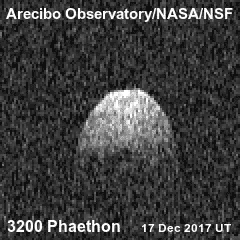
With the holidays behind us (alas), I want to be sure to cover the Arecibo observations of asteroid 3200 Phaethon, not only for their intrinsic interest but as a nod to the restoration of operations at the Puerto Rico observatory. We are fortunate indeed that the structural damage Arecibo suffered on September 20 because of hurricane Maria was relatively minor. Radio astronomy work was back in progress within days of the storm, though it took until early December before commercial power was restored and radar work could resume.
If you’re interested in radar astronomy, have a look at Alessondra Springmann’s How Radar Really Works: The Steps Involved Before Getting an Image, which is available via The Planetary Society. Springmann offers a detailed overview of radar operations with a splash of humor:
Arecibo Observatory is known for its 305-meter (1000-foot) diameter telescope and its appearances in Goldeneye and Contact. Aside from battling Bond villains and driving red diesel Jeeps around the telescope (grousing at the site director about the funding status of projects is optional), several hundred hours a year of telescope time at Arecibo go toward radar studies of asteroids. A group of four planetary radar astronomers at Arecibo (as well as collaborators and colleagues at institutions outside of Puerto Rico) is tasked with “finding them before they find us” by NASA’s Near-Earth Object Observation program. We study the orbits and surface properties of our rowdy neighbors, near-Earth asteroids.
‘Finding them before they find us’ indeed. Arecibo contains the most powerful radar system on the planet, making it a key asset for planetary defense, a great part of which is keeping an eye on asteroids close enough to be problematic. This is a facility we need to keep in action as we continue to build the catalog of near-Earth asteroids and examine their properties. The recently released observations of 3200 Phaethon were conducted from December 15 to 19, 2017.
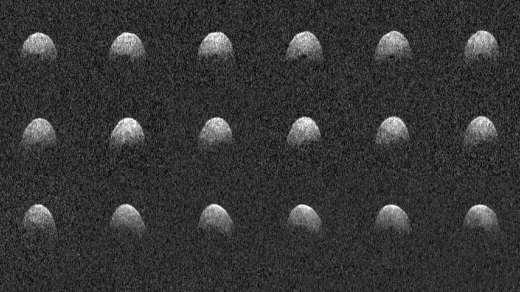
Image: These radar images of near-Earth asteroid 3200 Phaethon were generated by astronomers at the National Science Foundation’s Arecibo Observatory on Dec. 17, 2017. Observations of Phaethon were conducted at Arecibo from Dec.15 through 19, 2017. At time of closest approach on Dec. 16 at 3 p.m. PST (6 p.m. EST, 11 p.m. UTC) the asteroid was about 10.3 million kilometers away, or about 27 times the distance from Earth to the moon. The encounter is the closest the object will come to Earth until 2093. Credit: Arecibo Observatory/NASA/NSF.
About Phaethon itself, we know that it is about 6 kilometers in diameter, larger than previously thought, and is the second largest near-Earth asteroid in the category classified as ‘potentially hazardous.’ Size and close approach are determinants of which asteroid fits into that category, but work on any passing asteroid is useful because radar can study its size, shape, rotation, and surface features, while adding to our knowledge of its trajectory. Joan Schmelz, Arecibo’s deputy director, calls the facility “crucial for planetary defense work,” and that it is.
The images of 3200 Phaethon are the best we’ve yet taken, showing a spheroidal object with a large concave depression near its equator and a dark circular feature near one of its poles. The resolution in these images is about 75 meters per pixel.
“These new observations of Phaethon show it may be similar in shape to asteroid Bennu, the target of NASA’s OSIRIS-REx spacecraft, but more than 1,000 Bennus could fit inside of Phaethon,” said Patrick Taylor, a Universities Space Research Association (USRA), Columbia, Maryland, scientist and group leader for Planetary Radar at Arecibo Observatory. “The dark feature could be a crater or some other topographic depression that did not reflect the radar beam back to Earth.”
This asteroid is, by the way, the first to be discovered through images taken from a spacecraft, the craft in question being the Infrared Astronomical Satellite (IRAS), which produced data that Simon Green (Open University) and John K. Davies (then at Leicester University) examined to find the object. It is the parent body of the Geminids meteor shower and, given over thirty years of observations, is an asteroid with a well determined orbit, one well constrained for the next 400 years. The closest approach to Earth in 2017 was known with an accuracy of ±40 kilometers.

